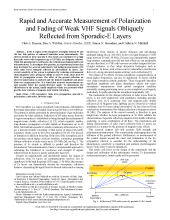New Sporadic E Measurement Results Published in IEEE Transactions on Antennas and Propagation
New Sporadic E Measurement Results Published in IEEE Transactions on Antennas and Propagation

The IEEE Transactions on Antennas and Propagation have recently accepted new research by Chris Deacon G4IFX, Ben Witvliet PE5B, Simon Steendam, and Cathryn Mitchell M0IBG entitled Rapid and Accurate Measurement of Polarization and Fading of Weak VHF Signals Obliquely Reflected from Sporadic-E Layers. This research uses signals produced by a network of 6 meter amateur radio beacons across Europe. Abstract: "In the E-region of the ionosphere, at heights between 90 and 130 km, thin patches of enhanced ionization occur intermittently. The electron density in these sporadic-E (Es) clouds can sometimes be so high that radio waves with frequencies up to 150 MHz are obliquely reflected. While this phenomenon is well known, the reflection mechanism itself is not well understood. To investigate this question, an experimental system has been developed for accurate polarimetric and fading measurements of 50 MHz radio waves obliquely reflected by mid-latitude Es layers. The overall sensitivity of the system is optimized by reducing environmental electromagnetic noise, giving the ability to observe weak, short-lived 50 MHz Es propagation events. The effect of the ground reflection on observed polarization is analyzed and the induced amplitude and phase biases are compensated for. It is found that accurate measurements are only possible below the pseudo-Brewster angle. To demonstrate the effectiveness of the system, initial empirical results are presented which provide clear evidence of magneto-ionic double refraction." A preprint of the research article is available from the University of Bath Website.
Congratulations, Chris, Ben, Simon, and Cathryn!
